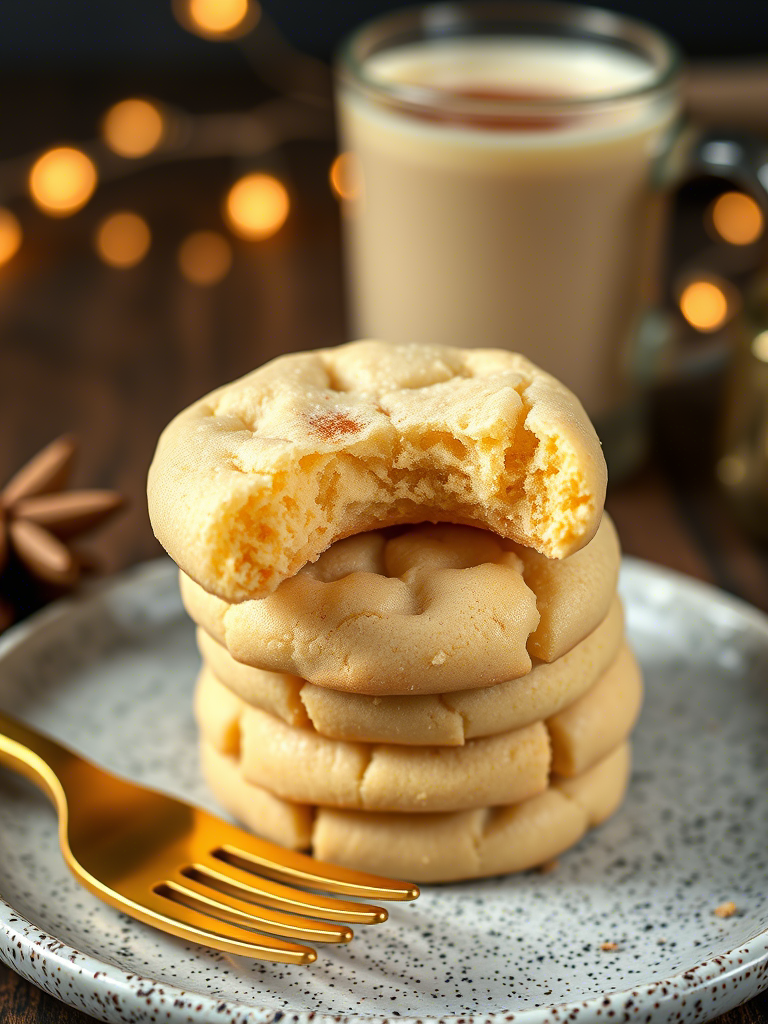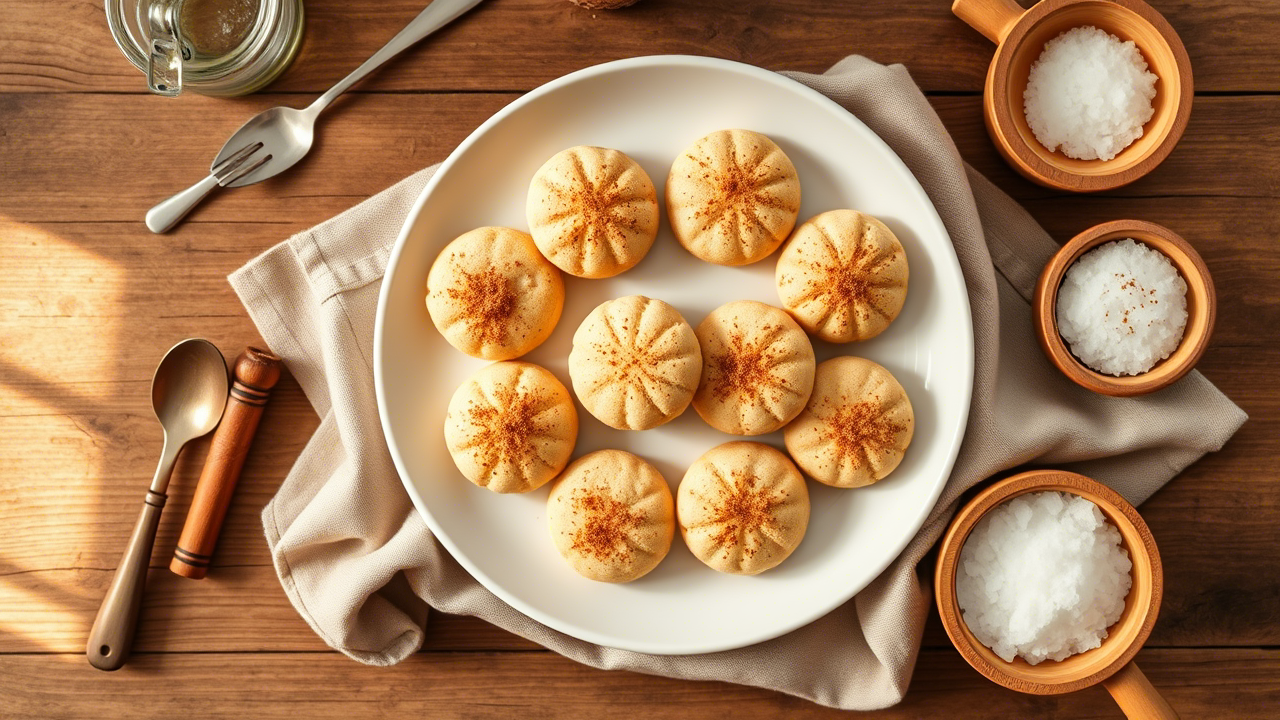Imagine biting into a sugar cookie so tender, it vanishes on your tongue like snow melting on warm skin. That’s the magic of Melt-in-Your-Mouth Eggnog Sugar Cookies—a dessert rooted in holiday nostalgia but elevated by technique, science, and bold flavor layering. And let’s be honest: we’re not here to play with mediocre textures or one-note flavors. We’re here to get serious about cookies.
This isn’t just another “cute” holiday cookie recipe post. We’re digging deep into the art and science of achieving that elusive melt-in-your-mouth texture. We’re also dissecting the role of eggnog—not just for flavor, but structure. Whether you’re a pastry chef, a food scientist, or just someone who knows their way around browned butter, there’s something in here for you.
The Origin of Eggnog Cookies: More Than Just Festive Gimmickry
Eggnog has been around for centuries, evolving from British posset to the rich, spiced custard drink we now spike and sip in December. It was only a matter of time before bakers turned the drink into dessert. But here’s the catch: many eggnog cookie recipes lean too hard on cinnamon, nutmeg, and sugary glaze. They forget what makes eggnog… eggnog. The creaminess. The gentle heat from booze. The luxurious mouthfeel.
That’s where these cookies turn heads. They don’t mimic eggnog—they transform it.
What Makes a Sugar Cookie “Melt-in-Your-Mouth”?
Let’s get nerdy for a sec. Texture in cookies is all about fat and flour interaction. Too much flour and the cookie gets tough. Too little and you’ve got a puddle. But it’s not just about ratios—it’s about fat type, sugar type, mixing method, and even bake temp.
To achieve that melt-in-your-mouth texture, three things are critical:
- High-fat content: Unsalted European-style butter with 82%+ butterfat makes a difference. American sticks with 80%? Still works, but not the same richness.
- Cornstarch or powdered sugar: These interrupt gluten formation, giving you that delicate, sandy crumb.
- Proper mixing technique: Creaming butter and sugar incorporates air. But overdo it, and you get puffy, cakey cookies. Undermix, and they collapse. It’s a tightrope.
Let’s put it this way: if your dough feels like play-dough, you’re halfway there. If it feels like clay, you’ve overmixed. That nuance? It’s where pros make their mark.

The Role of Eggnog: Not Just a Flavor Bomb
People toss eggnog into cookies like it’s just there for holiday vibes. Big mistake.
Eggnog introduces fat (via cream and egg yolk), sweetness, and spice. But it also brings moisture. And too much moisture can wreck the texture faster than you can say “bake at 350.”
Here’s how to balance it:
- Use reduced eggnog: Simmer eggnog until it reduces by half. This concentrates flavor and removes excess water.
- Use it strategically: Add to both dough and glaze—but sparingly. Think of it like vanilla extract: powerful in small doses.
- Know your brands: Store-bought eggnogs vary wildly. Organic types often have more yolk and real spice, while generic brands can be all thickeners and sugar. Read labels like your cookies depend on it. Because they do.
Real-World Trials: Getting the Texture Right
I ran this cookie through six iterations in the test kitchen. Here’s what we found:
- Trial 1: Standard sugar cookie dough + 2 tbsp eggnog
Outcome: Flavor barely noticeable. Texture? Dry. Meh. - Trial 2: Swapped milk for eggnog + added nutmeg
Better, but still lacking richness. - Trial 3: Reduced eggnog + brown butter + cornstarch
Jackpot. The texture melted like sable cookies. Flavor danced on the tongue.
This combo gave the cookie that whisper-light interior but sturdy enough edges to dip in milk (or bourbon-spiked nog, no judgment).
Eggnog Sugar Cookie Base Formula (For Pros)
Here’s a no-fluff breakdown of a pro-level formula:
- 226g unsalted butter, browned and cooled
- 75g powdered sugar
- 50g granulated sugar
- 1 egg yolk (not whole egg)
- 2 tbsp reduced eggnog
- 1 tsp vanilla bean paste
- 270g all-purpose flour
- 20g cornstarch
- ½ tsp kosher salt
- ¼ tsp freshly grated nutmeg
- Optional: 1 tsp rum extract for deeper eggnog vibe
Chill that dough. At least 3 hours. Why? It allows flour to hydrate fully and butter to firm up. This controls spread and improves flavor development.
Scoop, roll, bake at 325°F until edges are just golden. Don’t overbake. Seriously, don’t.
The Glaze: Subtle Sweetness, Not a Sugar Bomb
A lot of folks drown cookies in icing. But we want balance.
Whisk together:
- 1 cup powdered sugar
- 2–3 tsp reduced eggnog
- 1 pinch salt
- Dash fresh nutmeg
- Optional: 1 tsp dark rum or bourbon
It should be silky, not gloopy. You want it to hug the cookie, not shellack it.
Dip the top or drizzle, but always finish with a microdust of nutmeg. That one speck of spice gives aroma that hits your nose before you even bite.
Storage & Make-Ahead Tips: Pro Practices
Professionals know that timing is flavor. Here’s what to do:
- Dough can be frozen for up to 2 months. Scoop and freeze raw dough balls, then bake straight from frozen with a 1–2 minute time adjustment.
- Baked cookies stay fresh 5 days in airtight tin. Not a Tupperware. A tin. Why? Tins let air circulate just enough to keep texture snappy.
- Glaze only after cooling completely or it’ll slide off like icing on a hot doughnut.
Want to sell them at a holiday market? Pack them with a wax paper buffer, stack no more than 3 high, and include nutmeg in the aroma profile of your booth. Scent sells.

Misconceptions: Let’s Clear the Air
“Sugar cookies are boring.”
Only bad sugar cookies are boring. These are soft, warm, layered with spice and depth. If yours are bland, you’re using shortcuts.
“Eggnog is too strong for cookies.”
Only if you pour it in raw and unmeasured. Proper reduction and balancing with salt tame it into a smooth, luxurious backdrop.
“Cookies are simple—no need to test so much.”
Nope. Simple doesn’t mean easy. It means there’s no room to hide. Every ratio, every technique shows up in that bite.
Emerging Trends: Gourmet Cookie Evolution
Across pastry kitchens and artisan bakeries, sugar cookies are being reimagined. Think saffron sugar cookies with pistachio dust. Black sesame shortbreads. And now—eggnog sugar cookies with brown butter and nutmeg glaze.
Some are finishing with smoked salt. Others are playing with eggnog buttercream sandwiched between. These aren’t bake-sale cookies anymore.
A New York bakery recently added an eggnog sugar cookie to their $7-a-cookie lineup. It sold out in two days. People are chasing that melt-in-your-mouth feel like it’s gold dust.
It’s not just nostalgia—it’s texture and technique married to memory.
Final Thoughts: The Takeaways That Matter
Melt-in-your-mouth eggnog sugar cookies aren’t just about holiday cheer. They’re a study in fat, flour, and flavor. The secret? Intentionality.
Use high-quality ingredients. Balance moisture. Respect chill time. Play with spice like it’s jazz—just a little syncopation and you’ve got something magical.
Whether you’re baking for a crowd, curating a gourmet cookie box, or building a dessert menu that surprises, these cookies deserve a spot. Not just in December, but any time you want to remind someone—yourself included—what melt-in-your-mouth really means.
And hey, if you’re not licking the spoon after mixing the glaze… did you even bake?
Now go. Bake recklessly. Measure meticulously. And never underestimate a sugar cookie.
FAQs
What makes these eggnog sugar cookies “melt-in-your-mouth”?
A combo of high-fat butter, cornstarch, and minimal gluten development gives them that ultra-soft, tender texture.
Can I use store-bought eggnog in the recipe?
Yes, but reduce it on the stove first to concentrate flavor and control moisture.
Is it necessary to chill the dough?
Absolutely—chilling helps prevent spreading and improves texture and flavor.
Can I freeze the dough ahead of time?
Yep, scoop and freeze it raw for up to 2 months—just add a minute or two when baking.
What kind of butter works best?
European-style unsalted butter with at least 82% butterfat gives superior richness and mouthfeel.
Is the glaze too sweet?
Not at all—it’s balanced with salt, spice, and reduced eggnog for a mellow finish.
Can I make them without the glaze?
Sure, but you’ll miss out on that extra eggnog kick and aromatic top note.
Do I need to use rum or alcohol in the glaze?
Optional, but a splash of rum or bourbon deepens the eggnog flavor beautifully.
How long do the baked cookies stay fresh?
Up to 5 days in an airtight tin—tins work better than plastic for texture.
Are these cookies just for the holidays?
Nope—they’re festive, sure, but the flavor and texture are good all year long.

Mariana is a passionate home cook who creates delicious, easy-to-follow recipes for busy people. From energizing breakfasts to satisfying dinners and indulgent desserts, her dishes are designed to fuel both your body and hustle.
When she’s not in the kitchen, she’s exploring new flavors and dreaming up her next recipe to share with the Foodie Hustle community.

